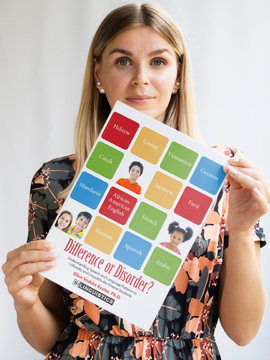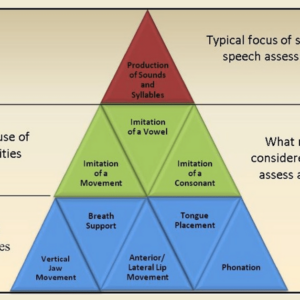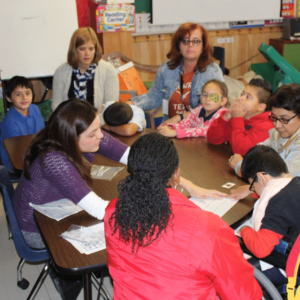Mastering the Art of Non-Standardized Language Assessments
$22.00

Course Type: Video – 1 1/2 hours
ASHA Course Code: Diversity, Equity, and Inclusion- 7030
Globalization has increased the need for diversity and inclusion efforts. As speech-language pathologists, it is critical that we understand and respect differences in culture, language and dialect to avoid misdiagnosis. This course will demonstrate best practices for administering non-standardized assessment measures to evaluate a range of different language skills.
Additional Information
| Population | Adult, Early Childhood, School Age |
|---|---|
| Duration | 1.5 hours |
| Credit | .15 Continuing Education Units |
| Topics | Evaluations |
| Format | Video |
Financial:
Scott Prath and Ellen Kester receive salaries from Bilinguistics. One product that will be discussed in the presentation is Evalubox, which is a product for which Ellen and Scott have a financial interest. Other free resources will be shared as well.
Non-Financial:
The authors do not have any nonfinancial relationships to disclose.
All Standardized Measures Include an Element of Bias
As speech-language pathologists, we are aware of the limitations and shortcomings of standardized tests, including the bias that exists in them. There is bias that exists in tools even for the monolingual English speakers that most tests were designed for. That bias only grows when we try to use the tools with children from diverse cultural and linguistic backgrounds. Does it mean we cannot use them at all? No, but it does mean that we need to be very mindful of the problems, and we need to use tests in a way that gives us information but does not penalize the child we are testing simply because they are from a different cultural and/or linguistic background. First, if a student scores below average on a tool that was not designed for them, we do not use those scores. They are very likely an underestimate of that student’s abilities. Second, we need to analyze item responses and consider whether there is a linguistic component or cultural component that influenced their answer. We walk through this process in the presentation. When we see patterns of missed items that result from cross-linguistic influence, we can discuss that in our report. We can also compile a list of skills the student exhibits based on their test responses, as well as weaknesses that were noted.
Considering Cultural and Linguistic Diversity in Language Sample Analysis
It is widely known that using language samples in the assessment process is a way to reduce bias. Many speech-language pathologists struggle with how to conduct and analyze language samples for their students from diverse backgrounds (Laing & Kamhi, 2003). Three important considerations include representation, language influence, and native language performance.
Considering representation in your book selection
Consider representation when you are selecting a book for a student to tell a story with. When we ask children to talk about something that is familiar to them, that is an easier task than if we ask them to talk about something that is unfamiliar to them. We’ll share loads of resources to help you identify books that span a broad range of cultures. Robertson (2021) notes that books can push people apart or pull them together, and encourages educators to consider how marginalized groups are represented when selecting a book. Our goal is to make our students feel supported so we get optimal performance.
Understanding Language Influence
The most important thing for us to consider when analyzing a language sample is cross-linguistic influence. When students make grammatical, morphological, or semantic errors when telling their story, it’s important to consider the native language and whether their error might be influenced from a pattern in their native language (Kester, 2012). In this presentation we will highlight the process and share resources for where to locate information about dozens of languages. This will help SLPs make decisions about whether errors are simply native language influence patterns or whether they are indicative of a language disorder.
Examining the Native Language
We cannot rule out language impairment for a bilingual child without considering both languages. When students’ language exposure is relatively balanced between languages (greater than 30% current exposure and use in each language) research indicates that testing in two languages helps better classify students with and without developmental language disorder (Peña, Bedore & Kester, 2016). For students whose current language exposure is 30% or less in one language, standardized testing in that language does not inform diagnostic decisions (Bedore, Peña, Anaya, Nieto, Lugo-Neris, 2018; Peña, Bedore, Lugo-Neris, Albudoor, 2020). It is still important to explore both languages using non-standardized measures, such as language samples. If we see a pattern in a child’s English language sample, we want to look at that feature in their native language as well. For example, if a child struggles with the past tense in English but can correctly mark past tense in their native language (assuming their language allows that), that is an indication of cross-linguistic influence and not a disorder. On the other hand, if a child struggles to express past tense in both of their languages, that is more indicative of a disorder.
Examine Learning Potential
One of the biggest problems with standardized tests is that they are static in nature. They allow us a quick snapshot of a student’s abilities at one moment in time. Knowing the inherent problems in standardized tests, it is critical that we dive deeper and examine a child’s potential to learn. We can do these using a test-teach-retest approach, also referred to as a dynamic assessment approach. We identify areas of potential need, teach those skills, and retest with practiced and novel items to explore change, or learning. Students who quickly learn and use skills in novel opportunities likely do not have a disorder. Those who struggle with to learn new skills with one-to-one teaching likely do have a disorder. This is one way to help us increase the clarity and confidence in our diagnostic decisions.
Using a combination of approaches and skilled analysis will help us accurately diagnose children from all linguistic and cultural backgrounds.
Participants will be able to:
• Identify linguistic influences in language samples
• Describe representation as it relates to selection of books to use in the assessment process
• Describe the importance of evaluating language potential in the evaluation process
• Describe current research on current language exposure and how that impacts your assessment process
Time-Ordered Agenda
10 minutes Background and Explanation for the Need for Non-Standardized Assessment Tools
25 minutes Administration of different non-standardized tools
25 minutes Analysis of responses on non-standardized tools (cross-linguistic influence, sentence complexity, narrative structure, vocabulary)
20 minutes Dynamic assessment – why it is needed and how to implement it
10 minutes Summary and questions
Need CEUs?

 Share
Share
 Tweet
Tweet
 LinkedIn
LinkedIn
 Pin
Pin
 Email
Email







